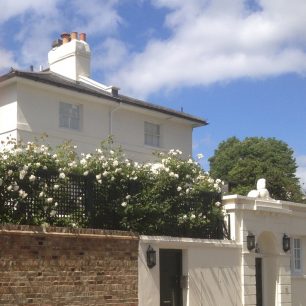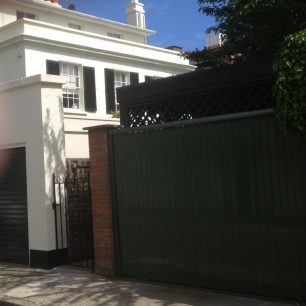Melina Place
Melina Place, which is a short street running westwards off Grove End Road, has had a mixed history of residents.
As the suburb grew it acquired a rather louche reputation : high walls and covert relationships being natural partners. But high walls and sedate calm also attracted all kinds of institutions designed to provide – at a cost lower than was possible in the central districts , but with easy access to wealthy friends and benefactors – a home for those who, for one reason or another, might be thought able to benefit from quiet and seclusion. Some of these were on a very small scale. By 1830 one of the capitals most select private asylums for psychiatric patients was established in Melina Place, with a superintendent licensed for the reception of lunatics by the Metropolitan Commissioners in Lunacy for 1831-32 with five patients.
Moving on during the century the inhabitants belonged to the artistic world, like George Colman the Younger (1762-1836) who was a theatrical manager and who lived at no.4 in 1811 and at no. 5 in 1824.
Phil May (1869-1903) the caricaturist, lived and died at no.5. (now 5a). In 1885 this had been a stable in 1885 but was converted.. No.6 (now no.6a) was the home of Henry Macbeth- Raeburn RA (1860-1947) , the Scottish painter and printmaker, Other artists living at no.12 included Allen C Sealy (1850-1927), a painter of race horses , who moved there in 1881 and in 1885 made a request for an extension to his house. Alfred and Rosalie Emslie and Frank Ogilvie were other artists at this address.
Dr William Farr, (d 1883) an epidemiologist who was the physician to Florence Nightingale, lived in the Place from 1846-60 .
Thomas Henry Huxley PC PRS FLS FRS ( 1825 – 1895) was an eminent biologist specialising in comparative anatomy and lived at no 11. He was known as ‘Darwin’s Bulldog’ for his advocacy of Darwin’s theory of evolution.
Arthur Machen (1863-1947), the Welsh author and mystic, lived at no.12 from where he entertained such friends as Augustus John, Wyndham Lewis and Jerome K Jerome. Arnold Toynbee CH ( 1889-1975 ), the British historian, lived at no.3.








Comments about this page
Another distinguished inhabitant was Doreen Lewisohn (1916-2000), a major figure in the paper conservation world. She worked for a number of museums, eventually chiefly the Fitzwilliam in Cambridge, leading her to move to Cambridge.
Add a comment about this page